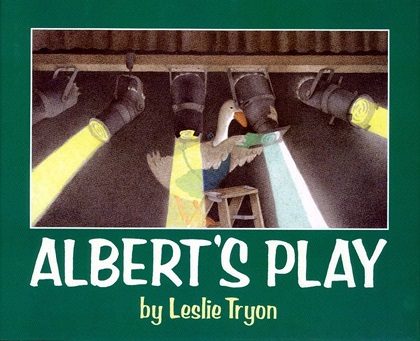
Author Leslie Tryon was a dancer on a cruise ship once, according to the jacket for “Albert’s Play” — and she’s also worked as a choreographer. But was she tapping that experience for her book about a stage-managing duck? In 1991 Tryon created the character of Albert the Duck, who helps the local school by building an alphabet on their playground. But the next year, when her publisher asked for a sequel, Tryon decided it should be about Albert putting on a play.
“It’s time for that yearly tradition, the production of Albert’s play. Will children who wish to audition be on stage after school today!”
It’s a wonderful book, since Tryon manages to rhyme every line of its descriptive text. But she’s also drawn illustrations – and there’s lots of them. (In some cases, there’ll be several pages with no words at all!) There’s pigs and porcupines, owls and kangaroos – all trying out for a part in Albert’s play. And both the pictures and the poem give the whole book a fanciful atmosphere.
“As soon as Albert had picked out the cast, He set the crew into motion. They began with a tub and a flagpole mast, and they painted the blue of the ocean…”
There’s a bucket of yellow stars which Albert hangs from a mobile. An owl helps him mount a yellow moon, while a pig holds the rope. An industrious little skunk looks up “auditorium” in a dictionary so he can write it on the play’s poster. And while animals scurry around the stage, a bunny and pig practice dancing.
“They dangled the stars and the dancing moon while working faster and faster. No one had yet found a runcible spoon – this could be a disaster.”
Albert’s casting calls for an owl and a pussycat, and soon it’s clear what play Albert’s producing. Even Tryon’s rhythm seems reminiscent of “The Owl and the Pussycat,” and the “runcible spoon” line is a give-away clue. (There’s no such thing as “runcible spoon.” It’s a nonsense phrase coined by Edward Lear when he wrote the poem in 1871.) And at the end of the book, Tryon re-publishes the poem in its entirety.
My favorite drawing shows the audience – all the older pigs, owls, and porcupines who’ve come to watch their children performing in the school play. But the animals have finished assembling their masks with scissors and glue, and showtime has finally arrived.
And it’s especially funny that the animals are acting out a play about animals – and that their animal costumes look even cuter than the animals themselves.